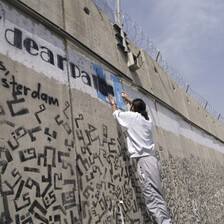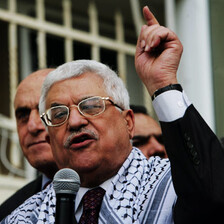The Electronic Intifada 28 September 2002

The wall surrounding Qalqiliya (Photo: Mark Zeitoun)
Most of the earliest reports on the wall suggest that it will be built “roughly along the Israel-West Bank border” (CNN, 17 June 2002). Many reports have limited themselves to questioning Israeli officials about Israel’s rationale for building the wall, noting the debate within Israeli society about what in Israeli lexicon is being referred to as “the fence”.
A reader of Jessica Steinberg’s article, A Faith in Fences (Newsday, 2 June 2002), for example, would be forgiven for concluding from the absense of a single Palestinian opinion, that the wall is of marginal concern to Palestinians.
Only following intervention in the Israeli High Court of Justice by a Palestinian human rights organisation did the euphemistically-named Israeli Defence Forces release an official map of the wall’s route. The map raises several grave concerns about the human rights of the Palestinians living near the wall.
The map does not include the 1967 demarcation line (known as ‘the Green Line’) between Israel and the West Bank. This suggests Israel will not take into account the international status of the West Bank in the course of building the wall. Indeed, the path of the wall on the map, when compared with the border of the West Bank, shows a de facto annexation of Palestinian territory to Israel.
What is fast becoming known among Palestinians as “Israel’s apartheid wall” will almost completely surround the Palestinian town of Qalqiliya in the northern part of the West Bank. Qalqiliya residents will see their freedom of movement severly curtailed, will be isolated from their neighbours in surrounding villages, as well as from their agricultural lands that fall on the ‘wrong’ side of the wall.

Above: The official Israeli map depicting the wall (EI)
In the first phase, 14 villages will be isolated from their agricultural lands. The total number of Palestinians living in these villages — trapped on the Israeli side of the proposed wall — is in the region of 11,000.
The Palestinian village of Baqa Sharqiya is one of the 14 affected, the wall cutting it off entirely from other villages and towns in the West Bank. A second wall is to be built around the town, cutting it from Israel. The ability of Palestinian residents of Baqa Sharqiya to move even small distances from their village will be entirely determined by Israel.
‘Closed Military Zone’
Israel’s wall will be 116 km long, and includes electric fences, trenches, cameras, sensors, and security patrols, and will ultimately extend to the full 350 km border around the West Bank.
The land between the wall and Israel will be declared a “closed military zone”. According to reports in the Israeli press, the 11,000 Palestinians that reside in this area will be issued “special permits” by Israel to allow them to enter the other parts of the West Bank, with thirty permanent checkpoints along the wall.
Palestinians living beyond the wall in the remainder of the West Bank will have to apply for special permits to enter the closed military zone.
Historically, Israel permit systems such as that which currently controls access to and from Gaza, and to Jerusalem, have seriously inhibited Palestinian freedom of movement, effectively isolating the West Bank from Gaza and closing Jerusalem to 99 percent of the Palestinian population.
The Threat to Agriculture
Palestinian rural society is based on a traditional economy where agriculture is a primary source of income. The agricultural economy has become increasingly important during this Intifada, as belligerent reoccupation, curfews, checkpoints and other forms of collective punishment and closure have isolated West Bank towns from each other, leading to a growing reliance on local and home produce for both immediate sustenance and employment.
Thousands of dunums of prime agricultural land, some of the most fertile in the West Bank, will be seized for the construction of the wall.
The Threat to Palestinian Water
According to Jad Isaac, director of the Applied Research Institute in Jerusalem, on an annual, per capita basis, Israelis consume more than four times as much water as Palestinians — although their population is only twice that of Palestinians — despite widespread dry periods where Palestinian municipal water supplies literally dry up for months during the summer.
The valuable western aquifer system, spanning the territory of the West Bank and Israel, lies in part under the Palestinian town of Qalqiliya. Israel’s isolation of Qalqiliya acts to extend its territorial control over this key Palestinian water source.
There is a serious need for journalists to investigate the scope of Israel’s construction plans and the impact they will have on Palestinians. The issues raised by the construction of this wall are happening elsewhere on a smaller but widespread scale daily.
While Israel increasingly cages the Palestinians and progressively asserts new control over Palestinian land and resources — a process known as “colonisation” — it is of vital important that the world bothers to look beyond the patently hollow rubrik of “security reasons” at the details of what is actually going on, and calls Israel to task for this latest, physical manifestation of its entrenched vision of a perpetual war with those whose land it shares.
The Electronic Intifada’s Nigel Parry contributed to this report.
Related Links



